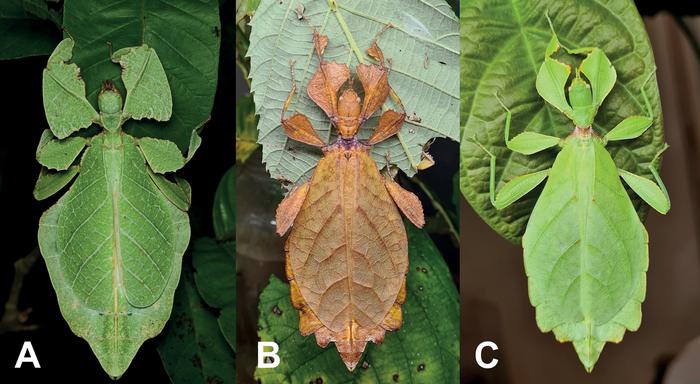An international research team including the University of Göttingen has described seven previously unknown species of leaf insects, also known as walking leaves. The insects belong to the stick and leaf insect order, which are known for their unusual appearance: they look confusingly similar to parts of plants such as twigs, bark or – in the case of leaf insects – leaves. This sophisticated camouflage provides excellent protection from predators as well as presenting a challenge to researchers. Genetic analysis enabled the researchers to discover “cryptic species”, which cannot be distinguished by their external appearance alone. The findings are not only important for the systematic study of leaf insects, but also for the protection of their diversity. The results were published in the scientific journal ZooKeys.

Credit: Vishwanath Gowda (A), Maxime Ortiz (B und C)
An international research team including the University of Göttingen has described seven previously unknown species of leaf insects, also known as walking leaves. The insects belong to the stick and leaf insect order, which are known for their unusual appearance: they look confusingly similar to parts of plants such as twigs, bark or – in the case of leaf insects – leaves. This sophisticated camouflage provides excellent protection from predators as well as presenting a challenge to researchers. Genetic analysis enabled the researchers to discover “cryptic species”, which cannot be distinguished by their external appearance alone. The findings are not only important for the systematic study of leaf insects, but also for the protection of their diversity. The results were published in the scientific journal ZooKeys.
Taxonomy – meaning the naming, description and classification of species – is difficult in the case of leaf insects: individuals of different species can be difficult to tell apart, yet there can be huge variations within a species. “Individuals of different species are often counted as belonging to the same species based on their appearance. We were only able to identify some of the new species by their genetic characteristics,” explains the Project Lead, Dr Sarah Bank-Aubin, Göttingen University’s Animal Evolution and Biodiversity Department. Some individual insects from India were previously thought to belong to a species that is widespread in Southeast Asia. But now the researchers have found out that they are a completely new species of leaf insects. Bank-Aubin emphasises: “The finding is important for species conservation: if all the individuals die out in India, it is not just a group within a species that is reduced, as was previously thought. In fact, a whole distinct species is being wiped out. This means that the Indian species is particularly important to protect.” Other newly discovered species come from Vietnam, Borneo, Java and the Philippines.
The researchers from Göttingen University worked with leaf insect expert Royce Cumming, City University New York. This research collaboration has led to the identification of over twenty new species. Dr Sven Bradler, who has been researching the evolution of stick and leaf insects at the University of Göttingen for more than 20 years, explains: “There are around 3,500 known species of stick and leaf insects and there are currently just over 100 described species of leaf insect. Although they only make up a small fraction of this diverse family of insects, their spectacular and unexpected appearance makes them unique.”
Original publication: Royce T. Cumming et al. On seven undescribed leaf insect species revealed within the recent “Tree of Leaves”. ZooKeys (2023). DOI: 10.3897/zookeys.1173.104413
Contact:
Dr Sven Bradler
University of Göttingen
Johann-Friedrich-Blumenbach-Institute of Zoology and Anthropology
Animal Evolution and Biodiversity Department
Untere Karspüle 2, 37073 Göttingen, Germany
Tel: +49 (0)551 39-25430
Email: [email protected]
www.uni-goettingen.de/en/207553.html
Journal
ZooKeys
DOI
10.3897/zookeys.1173.104413
Method of Research
Experimental study
Subject of Research
Animals
Article Title
On seven undescribed leaf insect species revealed within the recent “Tree of Leaves”
Article Publication Date
3-Aug-2023




